|

Scott
Sather, Combat Controller Extraordinaire was K.I.A., as the result of
an Iraqi ambush in Northern Iraq.
 |
Scott Sather was born June 21st, 1973 in Flint, Michigan. He was raised
in Clio, just a few miles north of Flint and attended Clio High School
where he graduated in 1991 just months after the first Persian Gulf War
came to a close. He enlisted in 1992 as a Combat Controller (CCT), and
throughout his years in service he had been stationed in McChord AFB,
Washington with the 22nd STS; RAF-Mildenhall and RAF Alconbury, England
with the 321st STS, and Lackland AFB, Texas.
His last assignment
was with the 24th Special Tactics Squadron – an elite Air Force Special
Operations unit assigned to the Joint Special Operations Command (JSOC)
out of Pope Air Force Base, North Carolina. The 24th STS, like it’s
Army and Navy JSOC special mission units is a Tier 1 top-priority unit
for the Department of Defense whose Combat Controller and Pararescue
(PJs) members number just in the double digits.
|
Scott
and his fellow 24th members were routinely assigned to directly support
JSOC counter-terrorist operations throughout Afghanistan, Iraq, and
elsewhere. Scott had previously served in Bosnia, Afghanistan, and the
invasion of Iraq in 2003. His last assignment was in March of 2003 as
part of the invasion of Iraq. At that time Scott was attached to a team
from the 75th Ranger Regimental Reconnaissance Detachment (RRD),
serving as a Combat Controller.
Scott and the RRD
team was part of a joint and clandestine special operations force led
by a squadron (possibly B Squadron) from Delta Force under command of
LTC (Ret.) Pete Blaber, and supported by a small element of the 1st
Ranger Battalion. The special operations task force objective was to
create a ruse to make Saddam Hussein and his top generals believe that
the main invasion was coming in from the west of Baghdad rather than
where the real attack would come – the south of Iraq. The force of less
than a hundred special operators with the help of roughly five tanks
from a conventional Army unit were tasked to make the Iraqis believe
that an entire armored military division was driving from the west to
attack Tikrit – which led Saddam to stay put in Tikrit rather than make
the run for Syria. The operation was chronicled in Pete Blaber’s book –
The Men, the Mission, and Me.
It was on the drive towards Tikrit
somewhere in the deserts of Western Iraq, on the night of April 8th,
2003 that Scott Sather lost his life during a combat operation after
eleven years of military service. He was 29 years-old. He was buried
two weeks later in Arlington National Cemetery where fellow CCTs and
PJs in red and maroon-colored berets, along with a handful of Ranger
tan berets in the crowd paid their final respects to their fallen
brother.
|
Arlington
National Cemetery was the site for Friday's
emotional tribute to a Pope airman killed in combat in Iraq.
Staff Sergeant Scott
Sather was killed two weeks ago in Iraq - the first airman killed in
the war. The 29-year-old Michigan native earned seven medals, including
the bronze star, during his Air Force career.
"Scott's a great
American," said Major Robert Armfield. "He was a hard-charging guy. He
wanted to be the best at what he did, and that's why he became an Air
Force Combat Controller."
Combat Controllers are
an elite group of fighters who lead allied aircraft to enemy targets.
There are only about 300 controllers, a group that had not suffered a
war casualty until last year.
Chaplain Mark Thomas,
a Sampson County native grew up near the base, works with the
controllers. He also conducted Friday's service.
"What I
try to do is focus on the fact of their faith," Thomas said. "I try to
help them out with hope."
|
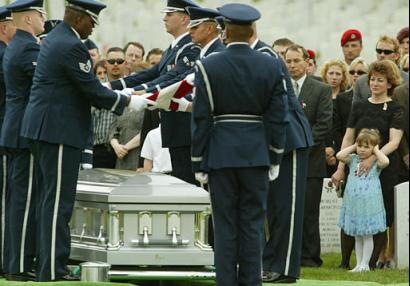 |
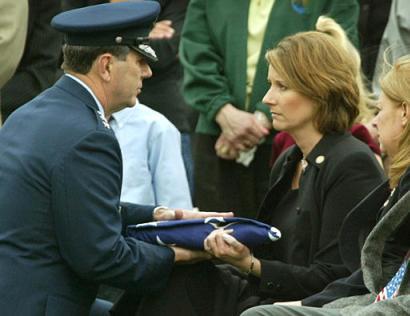 |
Thomas
said burial services like Friday's are never easy for anyone.
Chaplain Mark Thomas
said services like Friday's are always emotional and that his job is to
offer hope for the future.
"Seeing children and
young brides," he said, "knowing they paid such a sacrifice for our
freedoms."
A fellow controller
said two deaths in the unit in just more than a year is tough to take.
"All you can think
about is what you are in the military for and what you are doing," said
Tech Sgt. Westley Brooks, "and that's defending the freedoms we all
have."
Thomas' job is to
offer hope for the future, even when it seems impossible to reach.
"It's rewarding, in
a sense,"
he said, "knowing we've been able to establish some hope with them that
tomorrow will come, and they'll be able to walk through this." |
| Air Force Lieutenant General Paul
V. Hester, above, presents the flag to Melanie Sather, right,
wife of Air Force Staff Sergeant Scott D. Sather, from Clio, Michigan,
during his funeral at Arlington National Cemetery outside of
Washington Friday, April 25, 2003. The woman at far right is
Karin Craft, Sergeant Sather's mother. |
26
April 2003:
Courtesy of The Washington
Post
The first specks
of scarlet at the graveside of Staff Sergeant Scott D. Sather were
isolated, nearly lost in the mass of civilians in dark mourning
clothes. Then, after everyone else had settled in, the slim men in blue
uniforms and dark red berets approached by the dozens, forming a ring
of color around the outside of the crowd.

Sather, an Air
Force Combat Air Controller, was killed in Iraq on April 8, 2003.
Yesterday he was buried at Arlington National Cemetery surrounded by
service members wearing berets, the symbols of their elite status. In
addition to the scarlet worn by his fellow airmen, there were tan
berets on Army Rangers and at least one Army Green Beret in the crowd.
Sather, 29, a
native of Clio, Michigan, joined the Air Force in 1992. He soon began
training to be a Combat Controller, one of a unit of about 300
who work on the ground near or ahead of front-line combat troops and
guide attack planes to nearby targets.
These airmen,
whose slogan is "First There," are trained in parachuting, scuba diving
and combat survival as well as air traffic control. Retired Staff
Sergeant Mike Naylor, who served with Sather in Bosnia, said Sather was
drawn to the extreme aspects of the job.
"He wanted to
skydive. He wanted to scuba dive. He wanted to be a cowboy," Naylor
said after the funeral. "I mean, he wanted to be right up front."
Naylor said
Sather, an outstanding athlete in high school, was a fierce competitor.
While assigned to Bosnia, Naylor said, their unit was kept on alert and
could not stray more than a few minutes from its planes. To pass the
time, Naylor said, they would engage in highly competitive games of
Ultimate Frisbee.
Sather "was
fanatical about it. He didn't want to lose," Naylor said. "Everything
that he did was that intense."
There were also
lighthearted moments during those long periods of alert: Naylor said
that Sather played practical jokes on another airman named Eggers,
hiding eggs in his boots, then slipping away.
"Eggers never
found out who was doing it," Naylor said.
Sather's service
yesterday was the last of a week in which seven casualties of the Iraq
war were buried at Arlington. Fifteen have been laid to rest there
since April 10. Sather's coffin was positioned in a row of fresh graves
at the edge of a field that does not yet have headstones.
Sather was
stationed at Pope Air Force Base in North Carolina and married last
year, according to published reports. His widow, Melanie, sat with his
parents, Karin Craft and Rod Sather, at the grave site.
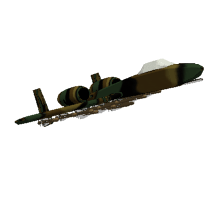 |
The service
began with a flyover by A-10 attack jets. After remarks by a chaplain,
flags were presented to his wife and parents.
At the
conclusion, other Combat Controllers -- in distinctive headgear and
uniforms, their dress pants stuffed into combat boots -- walked
forward, set a coin commemorating their unit on the coffin and saluted.
Major John
Koren, a retired Air Force officer who once was Sather's commander,
said afterward that the handsome, capable airman stood out even among
his elite colleagues.
"When they
asked me to put people on tough missions, he was first on my list,"
Koren said, adding that he could think of no higher praise for a
soldier.
|
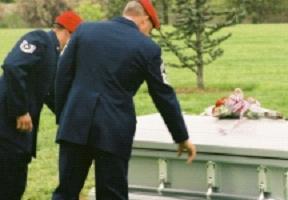 |
"He represented America," Koren said.
"He represented you and I. You can't ask for anything better than that."
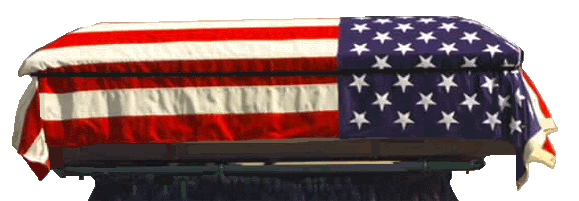
   

The pictures below were provided by Mike Naylor 




Camp
Sather is a
temporary base at Baghdad International Airport. The Air Force's
132-tent Camp Sather lies next to the airport's flight line but inside
a larger area that's controlled by the Army. As of August 2003, about
1,300 airmen live and work at Camp Sather, headquarters of the 447th
Expeditionary Group. The camp -- named for Air Force Staff Sgt. Scott
Sather, a Combat Controller killed in combat April 8 -- is on the west
side of Baghdad International Airport. The camp is unique to the Air
Force. No planes are based here; those that do arrive are serviced,
loaded and sent back out.
Most
of the Iraqi Armed Forces personnel and equipment have to transit
through Camp Sather on their way to other destinations in the region.
The 447th AEG provides security screening, vehicle transport, and
passenger services for them. In addition, squadrons here have assisted
with force protection, entry control, communications, fuel, medical and
supply needs of New Al-Muthana AB.
But
there's more to Sather than pallets, people and prisoner movement.
Almost daily, there is a VIP on the doorstep. The guest list includes
prime ministers, politicians, the secretary of defense, attorney
general and secretary of state.
Most
VIPs pass through the group's headquarters building. Dubbed the "Glass
House" for its ornate rooftop mosaics of mirrors, the building formerly
served as Saddam Hussein's personal military terminal.
US
Air Force Staff Sgt. Kristina Baker and her dog Rex are members of the
first Air Force canine teams deployed to Camp Sather, Baghdad
International Airport, Iraq. Rex searches a car carrying equipment to
set up a coffee shop at the camp. Staff Sgt. Baker and her dog are
deployed from Charleston Air Force Base, SC in support of Operation
Iraqi Freedom.
Airmen
from the 447th Air Expeditionary Group walk among tents during blackout
conditions. After a bombing in nearby Baghdad, the camp located at
Baghdad International Airport was bathed in darkness as a force
protection measure. Unlike Army camps in the area, all tents and
buildings that airmen live or work in at Camp Sather are
air-conditioned. Camp Sather also has telephones for stateside
calls home and Internet access is readily available and
dependable, unlike the Army, where soldiers spend hours waiting for
brief calls home or to get online for a few short minutes.
While
Army soldiers often travel about in open Humvees, airmen drive
air-conditioned SUVs and four-wheel-drive pickups that were shipped
here from other Persian Gulf bases. The Air Force also provides airmen
a laundry with washers and dryers to clean their uniforms. The Army
uses oil pans and buckets. Other amenities at Camp Sather include an
air-conditioned chow hall with sinks at the entrance for airmen to wash
their hands. The popcorn machine from Prince Sultan Air Base in Saudi
Arabia is installed in Camp Sather's movie theater. Airmen eat MRE's
for the most part (Chow hall is open for breakfast and dinner but with
duty schedules it is difficult to trade sleep for food sometimes), and
try to stay cool.
Unlike
most of their Army counterparts, Air Force personnel at Camp Sather are
strictly prohibited from leaving the airport. The closest they have
gotten to seeing Baghdad is an occasional trip to the Army post on the
other side of the airport. The sound of occasional gunfire can be heard
in the distance, but the airport's secured perimeter of several miles
makes the threat of harm very small.
Civil
engineers have replaced over 120 tents at Camp Sather with more modern
"Alaska" style tents in a $4 million project. These Alaska tents stay
cooler and offer more space.
As of
the Fall of 2005 there were about 750 Airmen here.
The
squadron and staging facility combined forces to make up the largest
Air Force medical squadron in Iraq. Formally known as the Mobile Air
Staging Facility, the unit can hold 100 mass casualty victims up to 12
hours. Routinely, it houses 50 beds with surge, which means it can
handle well over 50 patients at a time should a crisis occur. Doctors,
surgeons, nurse anesthetists, nurses and medical technicians work like
a well-oiled machine, 24 hours a day, seven days a week.
Scott Sather -- Strived for Excellence, Influenced Many Posted 5/19/2010
Commentary by Lt. Col. Darrell Judy 32nd Flying Training Squadron
commander
sent by
Joe Edwards |
5/19/2010 - VANCE AIR FORCE BASE, Okla. -- During a recent deployment
to Baghdad, Iraq, I had the distinct pleasure of serving with some of
our finest Airmen helping to bring peace and stability to that country.
During my tour, I had many shared experiences and made many friends I
won't soon forget.
One experience stood out from
the others; one that truly inspired me. This was the dedication of a
memorial to Staff Sgt. Scott D. Sather.
You may not know Sergeant
Sather, but he holds a significant spot in our military history. He was
the first U.S. Air Force Airman killed during Operation Iraqi Freedom.
A young man of only 29 years, he served as a special tactics Combat
Controller and had seen combat action in Kosovo, Afghanistan and Iraq.
His last assignment was with the
24th Special Tactics Squadron. During his time in Iraq he was the sole
Combat Control operator working with the 75th Ranger Regiment's elite
Residential Reconnaissance Detachment and directly contributed to
opening the first of five critical airheads used by the joint task
force in the opening days of OIF.
During that tour on April 8,
2003, he was killed by enemy fire in southwestern Iraq. In honor of his
sacrifice the military side of Baghdad International Airport is named
Sather Air Base.
On a crisp and sunny day in
November 2009, the 447th Air Expeditionary Group unveiled a very nice
and most appropriate stone memorial in the courtyard to not only
recognize Sergeant Sather's sacrifice but to afford Airmen, Soldiers,
Sailors and Marines the opportunity to read his story.

Pictures sent by Bob Blowers
What was impressive about the
memorial was not the detailed work on the stone or the size of the
audience that attended to show support, but rather the way in which
Sergeant Sather influenced so many people during his service in the Air
Force.
Many Airmen and Soldiers who
knew Sergeant Sather attended the ceremony that day and reminisced
about the great guy he was, not only as a personal friend, but as a
professional warrior and exceptional example to all. Sergeant Sather
was remembered for the way in which he lived, always with a focused
approach to excellence and striving to inspire others to do their best.
He had made a huge lasting impression to so many that even six years
after his death his memory continues to impact people's lives.
I submit Sergeant Sather did not
live his life to be remembered in this way, but it was fitting that it
was. Just like thousands of Airmen every day, he lived his life the
best he could, embodying the Air Force Core Values and striving to
serve his country proudly. It was those attributes and actions that had
such a significant and lasting influence on so many. He left a legacy.
Sergeant Sather truly embodied
the Air Force Core Values of Integrity, Service and Excellence. By
living these values and inspiring others to do the same, his legacy
lives on. The lesson I took with me that day is that each of us will
have an influence on someone every day.
You don't have to be a
supervisor or leader to make a huge difference in people's lives. Any
Airman can do it just by striving for excellence and motivating others
to do the same. It might only be a small event, but it is likely to
leave a lasting impression.
By living our lives like
Sergeant Sather lived his, we all can have a positive influence on our
family, friends, servicemembers and country.
| What Many Find Hard To Remember, I Find So Hard To Forget |
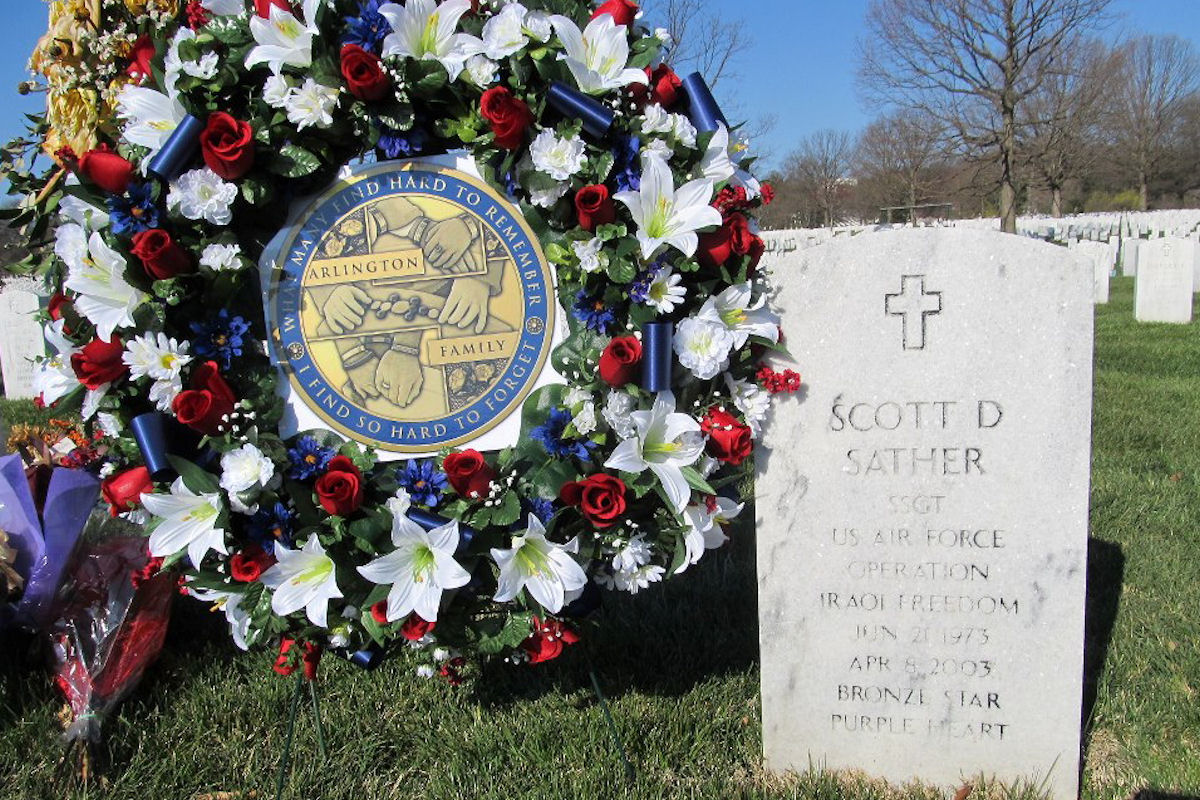 |
This wreath was taken to every single site in Sec 60 forward of about stone
7800 from April to Sept 2013 to capture such a photo for every single family who is
out there 10 years from the start of combat coming to 60. I have only one
contact relative to Sather who is a fellow with an org (Sentinels of Freedom)
have not ever met Sather’s actual folks,-- but I’m guessing that your site may
care to display this particular photo… I put all of the albums (row by row) on
a FB page I share only with families and unit members.. Sather is in the York’s
Original Settler’s album.. *(York side of the field, first row). The inset on
the wreath was sanctioned, as was the wreath and the album archiving - by 400 of
the neighboring families. The inset is actually the family coin (I minted as my
gift to them).. they voted for that to be the inset on this wreath. If you
can get this image to the Sather folks, I’ll be pleased. If you care to get in
the loop to see the others my FB is Holly AtArlington. (presents as a first
and last name)..
|
|

|